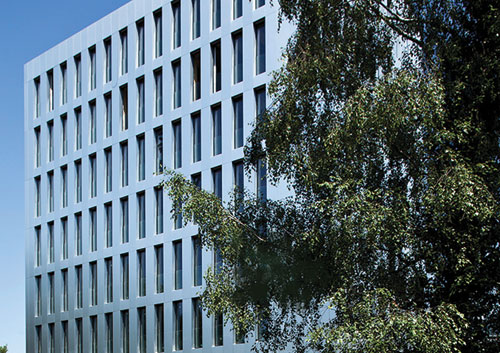Tall Wood Takes a Stand
| COST BENEFITS: FOUR- AND FIVE-STORY STRUCTURES |
Wood-frame structures built using dimension lumber and traditional construction methods are also getting taller, and wood’s cost competitiveness is a driving force in that growth. » Emory Point, a mixed-use project near Emory University in Atlanta, Georgia, is a 442-unit project that includes one five-story wood-frame building over slab-on-grade and three four-story wood-frame buildings over one-story concrete podiums. Brad Ellinwood, P.E., of Ellinwood + Machado Consulting Structural Engineers, says they considered a number of systems but wood was the most economical. When they evaluated the cost of the structural frame portion only, the wood design cost approximately $14 per square foot compared to $22 per square foot for a 7-inch post-tensioned concrete slab and frame. The huge wood-frame project was completed in just over a year, which provided additional cost savings. » Applewood Pointe at Langton Lake is a senior housing project in Roseville, Minnesota. The 48-unit four-story wood structure had a one-hour fire rating; it was sited over a three-hour rated pre-cast concrete parking garage, for a total of 123,964 square feet. According to Roger Johnson with JSSH Architects of Minnetonka, Minnesota, wood-frame was the most cost-competitive option, at $80 per square foot complete. |
 |
LifeCycle Tower ONE’s prefabricated hybrid wood/concrete slab system is supported by a central stiffening core on the interior and by glulam posts on the exterior. Photo courtesy of Cree Buildings, Inc. |
What is FFTT?
FFTT, a term coined by Green and Karsh, stands for 'Finding the Forest Through the Trees.' The non-technical acronym represents the mass timber panel approach described in his Tall Wood report. Green's FFTT methodology uses mass timber panels and glulam as primary structural members to achieve potential building heights of up to 30 stories.
The structural details of FFTT feature a 'strong column-weak beam' balloon-frame approach, which uses large-format mass timber panels (CLT, LVL, or LSL) for the vertical structure, lateral shear walls, and floor slabs. The 'weak beam' component is made of steel beams bolted to the panels to provide ductility and to allow the building to perform under wind and seismic loading conditions. The 'strong column' uses engineered wood (glulam) columns and large-format mass timber panels as vertical structure, lateral shear walls, and floor slabs. Concrete is used for the foundation up to grade.
The system offers a number of benefits, including adaptability to different building types and quick installation. Green says the tilt-up wall configuration of a balloon-frame approach allows the builder to build up to six floors at a time, instead of erecting the building one floor at a time. “They tilt up the walls, and then carefully put the floors into place,” says Green. “Height of the walls, comprised of CLT, LSL, or LVL, is limited only by manufacturing and transportation restrictions of a panel, and by the contractor's ability to lift a large panel into place if they're building in a dense urban area. It is a very different way to build a tall building.”
Why Use Wood in Tall Structures
There are many advantages that will lead to the increased use of wood in tall buildings, including environmental benefits, financial advantages, faster installation, and others.









